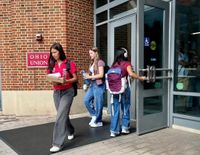As the fall semester kicks off at Ohio’s universities, students are navigating a dramatically altered higher education landscape—one shaped by a flurry of new federal and state policies under President Donald Trump’s second term. From sweeping changes to student visa rules and diversity programs to major shifts in student loan financing, the effects are rippling across campuses and into the lives and futures of Gen Z students.
On August 27, 2025, the Trump administration announced a proposed rule that would fundamentally change how long foreign students can remain in the United States. According to CNN, the new regulation would limit student visas to a fixed period matching the duration of their academic program, but not exceeding four years. This is a stark departure from the current system, which allows foreign students with F visas to stay for as long as their studies require, regardless of length. The rule also maintains a 60-day grace period after graduation for students to either maintain legal status or depart the U.S.
Beyond students, the proposal extends to cultural exchange visitors and foreign media, capping their admission periods at 240 days—with the possibility of extensions for the same length. The Department of Homeland Security (DHS) defended the move, with a spokesperson stating, “For too long, past Administrations have allowed foreign students and other visa holders to remain in the U.S. virtually indefinitely, posing safety risks, costing untold amount of taxpayer dollars, and disadvantaging U.S. citizens.” The spokesperson added, “This proposed rule would end that abuse once and for all by limiting the amount of time certain visa holders are allowed to remain in the US, easing the burden on the federal government to properly oversee foreign students and their history.”
These changes come amid a broader crackdown on international students. CNN reports that more than 6,000 student visas have been revoked so far in 2025—nearly four times as many as during the same period last year. The State Department attributes these revocations to overstays and legal violations, including assault, driving under the influence, burglary, and “support for terrorism.” In June, embassies and consulates were instructed to scrutinize student visa applicants for “hostile attitudes towards our citizens, culture, government, institutions, or founding principles.”
The impact of these policies is not just felt in Washington. On campuses like Kent State University and Ohio State University, international students are weighing their options. Deepan Wagle, a sophomore from Nepal studying mechatronics engineering at Kent State, told Cleveland.com that he’s considering leaving the U.S. after graduation in 2027. “I feel like I came to the U.S. just as its downfall has begun,” he said, citing concerns about Trump’s consolidation of power and the tightening of immigration and education policies. Wagle isn’t alone; students across Ohio are expressing anxiety about how these changes will shape their futures.
For many, the most visible transformation has been the elimination of diversity, equity, and inclusion (DEI) programs. In February 2025, Ohio State University closed its Office of Diversity and Inclusion and the Center for Belonging and Social Change to comply with Trump’s executive orders and the anticipated passage of Ohio Senate Bill 1, which bans DEI in public colleges. The Office of Institutional Equity was renamed the Office of Civil Rights Compliance, and while some programs were transferred to other departments, they were modified to fit the new mandates.
Zen Bowers and Cadence Linn, both sophomores majoring in ecological engineering at OSU, recalled the abruptness of the closures. “All the safe spaces created for people of color are now being more inclusive to people who are not as oppressed, like white students and men,” Bowers observed. Linn added, “It’s a little bit scary to me. There shouldn’t be so much political control over education. The whole thing about education is that it’s not supposed to be touched.”
Ohio’s Senate Bill 1, which took effect in 2025, goes even further. The law not only bans DEI initiatives but also restricts universities from taking positions on controversial topics such as climate policy, electoral politics, immigration, marriage, and abortion. It also introduces post-tenure reviews that could result in the firing of professors who “do not meet performance expectations.” Jaxon Stevens, an OSU freshman, remarked, “I am bi, though. That kind of puts a little bit of hazard in the back of my mind.” He considered leaving Ohio to escape SB 1 but ultimately stayed for financial reasons.
For students like Kelly Hauck, a freshman from Long Island attending OSU on a Morrill Scholarship, the new rules have personal consequences. The scholarship’s eligibility criteria had to be modified due to the DEI ban, though her award was preserved. Hauck said, “I’m a little worried for everything but I’m trying to stay positive and not consume too much media because it does give me a little anxiety.”
The Trump administration’s influence extends to the financial realm as well. Under the “One Big, Beautiful Bill Act,” signed into law this year, the federal Direct PLUS loans that allowed graduate students to borrow the full cost of their education will end next year. Instead, loans will be capped at $20,500 annually, with a $100,000 lifetime limit. This shift is expected to make graduate education less accessible for middle- and low-income students, who may have to rely on private loans with higher interest rates and fewer protections.
OSU freshman Fouvia Ahmed, a first-generation college student with dreams of medical school, voiced her worries: “I don’t know where I’m going to get the funds, especially when they passed that bill. It’s scary.” Hannah McCauley, a freshman at Kent State planning to study journalism and history, is also troubled by the new repayment rules. “Under the big, beautiful bill, instead of having six months to start paying things back, we have to start doing so immediately,” she explained. Despite these obstacles, McCauley is determined to pursue her passion for journalism, motivated by the need to combat misinformation.
Even students in specialized fields are feeling the pinch. Jonah Axelrod, a Kent State freshman in the professional pilot program, noted that federal workforce cuts have affected the Federal Aviation Administration, leading to air traffic control staffing shortages. “I’ve been impacted sometimes because I fly out of a New York-area airport. New York has been affected by it. You know, all the ATC outages. There have been times where you’ve had less controllers at my airport,” he explained.
Political opinions on campus remain sharply divided. While some Gen Z students are vocal in their criticism of President Trump—like Axelrod, who said, “Yeah, he sucks. Get out of our country”—others, according to Montclair State University professor Gabriel Rubin, are more cautious, especially conservative students who fear backlash and often request anonymity in interviews.
As Ohio’s Gen Z students adapt to these sweeping changes, their experiences reflect a generation caught between shifting political winds and their own hopes for the future. Whether these policies will achieve their intended goals—or spur a new wave of activism and adaptation—remains to be seen, but the stakes for higher education and the lives it shapes have rarely felt higher.




